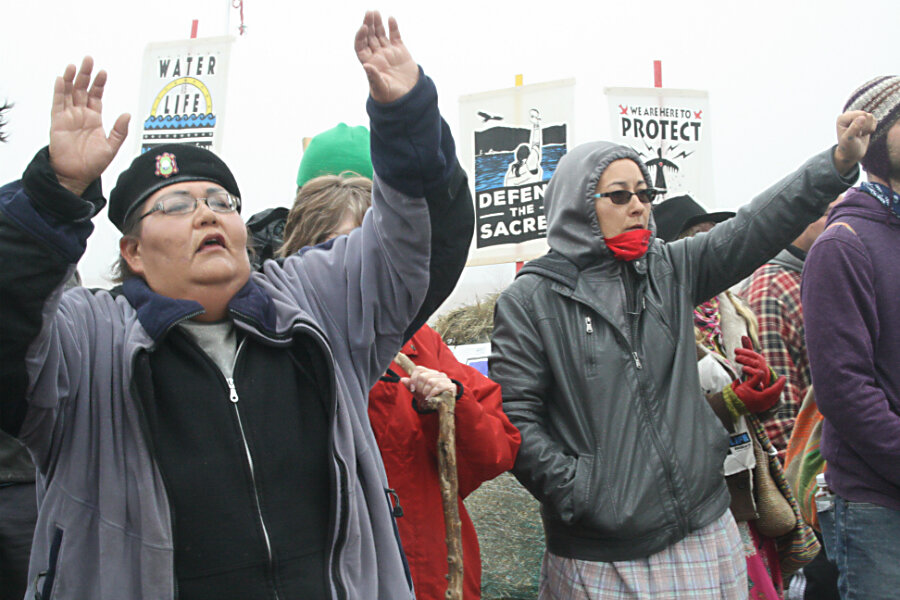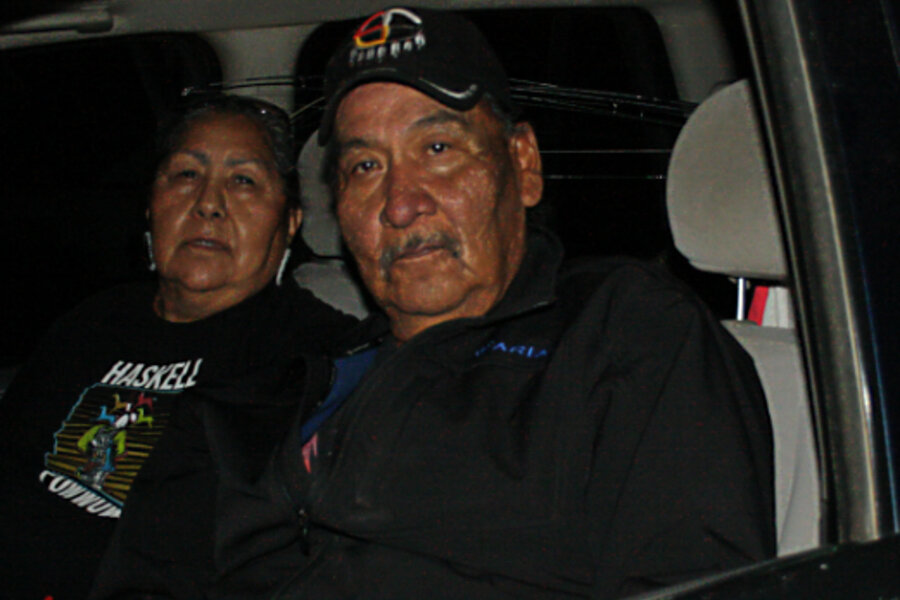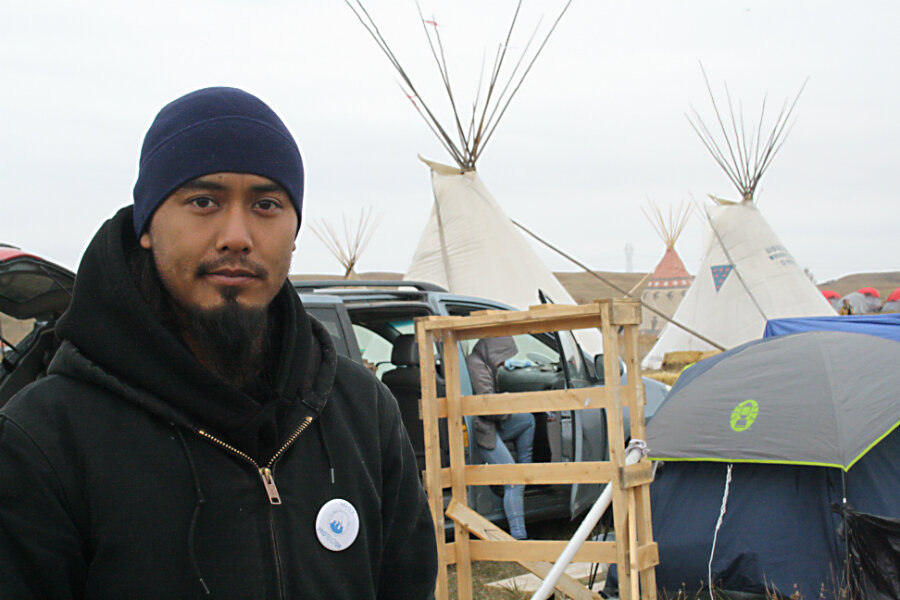The protests are about water, fossil fuels, and questions of tribal sovereignty. But beneath all that, tribes from across the US say they’re unifying around revitalized Indian traditions and religion.
By Henry Gass
The Christian Science Monitor, November 1, 2016 —

Henry Gass/The Christian Science Monitor
CANNON BALL, N.D.—With night falling over the sprawling town of tents and teepees here, BJ Kidder describes Sitting Bull massing his forces in this very same spot, at the confluence of the Missouri and Cannonball rivers, before the Battle of Little Big Horn.
This time, thousands of Native Americans haven’t come to wage war. They have come to protest through prayer.
And six years ago, Mr. Kidder believes, his father predicted it.
“My dad said all the [native] people are going to come together from everywhere to see how we’re destroying Mother Earth, but when that time comes, I’ll be gone.”
Here at the front lines of protest against the Dakota Access Pipeline, every movement is weighted with the indigenous history of the region – a tragic history that’s reflected in Mr. Kidder’s own life story. Born and raised in the neighboring Standing Rock Sioux reservation, he describes being beaten as a boy by priests at a Catholic school, and watching as the 1973 occupation of Wounded Knee energized and united Indian country like never before.
Now looking out over the main Oceti Sakowin camp – an ancient collective name for seven Dakota peoples and now home to the largest gathering of Native Americans in modern history – he sees signs of change and progress for his people.
“A lot of hard things have been done to our people,” Kidder says. “It’s finally changing, slowly, after years of barely changing.”
Indeed, talk to Native Americans here, no matter the tribe, and you will hear many of the same things. After generations of oppression and neglect, mired in systemic poverty and prevented from doing basic things like practicing their religion, the protesters here – who prefer to be called “water protectors” – see their stand against the Dakota Access Pipeline (DAPL) as not just a battle against a specific project, but public signs of a reconnection with their collective traditions and religion.
It is this reconnection, they believe, that has sustained the protest for over seven months. And in turn, it could have broader ripple effects both on and off tribal lands. For one thing, the protests here may be turning Native Americans into a leading force in the domestic movement on climate change.

Henry Gass/The Christian Science Monito
The $3.8 billion pipeline, which is more than half-built already, would cross four states and carry up to 570,000 barrels of crude oil per day from North Dakota’s Bakken oil patch to Illinois pipelines that feed Gulf Coast refineries. Dallas-based Energy Transfer Partners, the pipeline’s developer, says it will create thousands of local construction jobs and millions in tax revenue. The planned route would bring the pipeline within half a mile of the Standing Rock Sioux reservation, however, and the tribe believes the pipeline has destroyed sacred sites and may pollute the Missouri River, a key water source.
After police violently cleared protesters off a camp directly in the pipeline’s path last week, construction has been progressing rapidly and the pipeline is now just a few miles from the Missouri.
It isn’t clear when construction could finish, but it is clear that the protest has had a profound effect on Indian country. Regardless of the ultimate outcome, the protest is likely to only further build momentum for native activism that has been growing since the Keystone XL protests and the Idle No More movement of earlier this decade.
Joye Braun, a protest organizer, traces this revival of indigenous activism to a very specific point: the American Indian Religious Freedom Act of 1978. Prior to that act, many native practices and rituals had been prohibited by federal laws and policies. (For example, the laws protecting endangered or threatened species restricted tribal access to eagle feathers or bones.) Native Americans have been slowly revitalizing those practices.
“In the 1980s we didn’t know how to do what we’re doing now,” Ms. Braun said last week, sitting under several blankets around a camp fire at the protest’s “front line” directly in the path of the DAPL’s planned route.
“It’s really important to remember that it was only 1978 that we as indigenous people had the legal right to even pray in our way,” she added. “Everything we do is in prayer here, and prayer is an essential part of revitalization of our cultures and our languages.”
Those principles were tested three days later. After police dismantled the frontline camp, clearing a path for construction crews to the Missouri, some more militant protesters have called for more aggressive tactics to stop the pipeline.
But over the previous seven months – before the national media spotlight found the protest – this renaissance of Native American activism has been centered on prayer, and fostered through a potent blend of revitalized indigenous traditions, modern hashtag activism, and the nonviolent direct action principles of Mohandas Gandhi and Martin Luther King Jr.

Henry Gass/The Christian Science Monitor
And native youths have been a driving force behind the protest, Braun says. Part of that is technology, though youth involvement hasn’t been limited to popularizing hashtags and live-streaming Internet videos. They have also been doing their part to bring Indian country back in touch with its traditions and religion.
“The youth aren’t buried down with all the things that we older ones carry on our backs. They don’t carry the same luggage that we do,” she says. “They carry luggage – they carry a lot of it – but it’s not the same luggage.”
“They are moving us forward into a world where unity truly is possible,” she adds.
The entire DAPL protest began with young Native Americans reviving the traditional “crow hop” relay run to raise awareness – one person running two-thirds of a mile or so, then being relieved by another runner, and so on. The first relay went through the Standing Rock reservation; the second went 500 miles from the reservation to the Omaha, Neb., headquarters of the US Army Corps of Engineers, the agency responsible for permitting the pipeline; then a third went 2,000 miles from North Dakota to Washington, D.C., ending with a rally outside the White House.
And there’s Nathan Piengkham, a young man from the Kalispel reservation in Washington State, who traveled to the protest in the summer to join a canoe paddle down the Missouri. The canoe they brought was the first his tribe had made for 100 years, he says. They gave it as a gift to the Standing Rock Sioux, who also hadn’t had a canoe for a century.
“We’re getting our traditions back,” he says. “Canoes, horses, [protecting] the earth – those are our traditions.”
A fire crackles in the background, and some protesters laugh as a First Nations man from Ontario recounts his experience getting arrested during an action a few days earlier.
“I thought I was just going to come here, pray, and go back,” the man said.
Mr. Piengkham had similar thoughts. He had planned to return to Kalispel in October, then his little brother showed up at the protest. With the pipeline inching closer to the river, and rumors of imminent police action heightening tension in the camps, he decided to stay put.
The next day, that tension almost boiled over. As actor Mark Ruffalo delivered an array of solar panels to the main camp, word reached the main camp that police were moving in.

Henry Gass/The Christian Science Monitor
Dozens of protesters rushed to the front line in time to see two armored police vans, sent to negotiate, disappear into the morning fog. For the rest of the morning, protesters gathered at the barricade there, singing, dancing, praying, and staring down the fog-shrouded highway.
Police would return the next day, this time not to negotiate. While many protesters prayed peacefully as officers in riot gear dismantled the front line camp, ordering them to move off private land and deploying pepper spray and concussion grenades, others retaliated by setting fire to cars and throwing projectiles, including homemade firebombs.
Some peace has been restored to the area since those clashes last week, and Jose Aguto, a former senior policy adviser with the National Congress of American Indians now with the Friends Committee on National Legislation, believes the nonviolent activism fueled by revitalized native traditions could see indigenous people become leaders in the climate movement beyond the DAPL protest.
“The spiritual dimension that’s being offered here is what I think is resonating with a lot of people and finding a place of growth for them,” he says.
“This is the tribes really affirming their identity and who they are,” he adds. “It’s a great opportunity for tribes to lead.”
Crouching around a wood stove in his tent one frigid evening last week, Johnnie Aseron, an Oceti Sakowin camp organizer, says that as protesters prepare to dig in for the winter, “there’s the hope that prayers that come from here can be heard by others.”
“That’s really, truly how this began. We came to pray about it,” he adds. “To me, this started with prayer, and it will end with prayer.”








